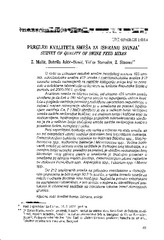Приказ основних података о документу
Pregled kvaliteta smeša za ishranu svinja
Survey of quality of swine feed mixes
| dc.creator | Mašić, Zoran | |
| dc.creator | Jakić-Dimić, Dobrila | |
| dc.creator | Stanaćev, Vidica | |
| dc.creator | Sinovec, Zlatan J. | |
| dc.date.accessioned | 2020-12-21T09:24:05Z | |
| dc.date.available | 2020-12-21T09:24:05Z | |
| dc.date.issued | 2002 | |
| dc.identifier.issn | 0350-2457 | |
| dc.identifier.uri | https://vet-erinar.vet.bg.ac.rs/handle/123456789/1966 | |
| dc.description.abstract | U radu su prikazani rezultati analize- hemijskog sastava 455 uzorka, mikrobiološka analiza 412 uzorka i mikotoksikološka analiza 212 uzorakasmeša namenjenih za različite kategorije svinja koji su pristizale u ovlašóene laboratorije na kontrolu sa teritorje Republike Srbije u periodu od 2000-2001. godine. Analizom smeša za ishranu svinja, od ukupno 455 uzorka smeša utvrđeno je da čak u 185 slučajeva smeše ne ispunjavaju uslove kvaliteta u pogledu sadržaja proteina predviđene zakonskom regulativom, a najveći stepen odstupanja utvđen je u smešama za prasad Ispitivanjem sadržaja Ca, P i NaCl utvrđeno je da u velikom broju slučajeva smeše sadrženedovoljne količine, a u znatnom broju i količine koje su nedozvoljene. Ispitivanjem sadržaja pojedinih mikroelemenata utvrđeno je da u velikom broju slučajeva smeše sadrže nedovoljne količine posebno bakra, mangana i cinka. Broj saprofitskih bakterija vrlo varira u odnosu na vrstu smeša, ali su svi pregledani uzorci sadržali dozvoljen broj saprofitskih bakterija. Determinacijom bakterija najčešće su izolovani Baci/lus spp„ Staphylococcus spp., koliformne bakterije i Micrococcus spp.. Većina ispitivanih smešaza ishranu svinjasadržalaje dozvoljenbroj klostridija, a u manjem broju uzoraka, pretežno zaprasad, je utvrđen nedozvoljen broj klostridija, Broj gljivica plesni u smešama je značajno povećan u smešamaza ishranu mladih životinja, determinacijom plesni najčešće su izolovani Penicillium spp., Aspergillus spp., Fusarium spp. i Mucor spp.. Od 212 analiziranihsmeša na prisustvo mikotoksina u dozvoljenim granicama je bilo svega 30.2 00smeša, a razlike između smeša za mlade i odrasle životinje nisu značajne, Najčešće prisutni mikotoksini su zeara/enon i ohratoksin, a sve smeše u kojima su identifikovani aflatoksini ili trihoteceni sadržale su navedene toksine iznad dozvoljenih granica. | sr |
| dc.description.abstract | The paper presents the results of analyses of the chemical composition of 455 samples, microbiological analysis of 412 samples, and mucotoxicological analyses of 212 samples of feed mixes for different categories of swine which arrived for control at authorized laboratories from the territory of the Republic of Serbia during the period from 2000 until 2001. The analyses of 455 swine feed mix samples showed that as many as 185 feed mixes do not meet the quality condition on protein content envisaged by legal regulations, and the highest discrepancy was determined in feed mixes for piglets. Analyses of Ca, P and NaCl contents showed that the mixes in a large number of cases contain insufficient quantities, and in a considerable number even quantities which are not permitted. Analyses of the contents of certain microelements showed that mixes contain insufficient quantities in a large number of cases, especiaily of copper, manganese and zinc. The number of saprophytic bacteria greatly varied depending on the type of feed mix, but all examined samples contained a permitted number of saprophytic bacteria. These analyses most often isolated Bacillus spp., Staphylococcus spp., coliform bacteries, and Micrococcus spp.. Most examined samples contained a permitted number of Clostridia, and a smaller number of samples, mostly for piglets, showed an impermissible number of clostridia. The quantity of mold fungi in mixes was significantly higher in mixes for young animals, and the determination of fungi most frequently resulted in the isolation of Penicillium spp., Aspergillus spp., Fusarium spp., and Mucor spp.. The mucotoxin analysis of 212 feed mixes showed that only 30.2% were within permitted ievels, and the differences between the mixes for young and adult animals were not significant. The mucotoxins most often present were zearalenon and ochratoxin, and all mixes in which aflatoxin and trychotecenes were identified contained these toxins in quantities above permitted tevels. | en |
| dc.publisher | Fakultet veterinarske medicine, Beograd, Srbija | |
| dc.rights | openAccess | |
| dc.rights.uri | https://creativecommons.org/licenses/by/4.0/ | |
| dc.source | Veterinarski Glasnik | |
| dc.subject | feed quality | |
| dc.subject | diet | |
| dc.subject | swine | |
| dc.subject | kvalitet hrane | |
| dc.subject | ishrana | |
| dc.subject | svinje | |
| dc.title | Pregled kvaliteta smeša za ishranu svinja | sr |
| dc.title | Survey of quality of swine feed mixes | en |
| dc.type | article | en |
| dc.rights.license | BY | |
| dcterms.abstract | Синовец, Златан Ј.; Јакић-Димић, Добрила; Машић, Зоран; Станаћев, Видица; Преглед квалитета смеша за исхрану свиња; | |
| dc.citation.volume | 56 | |
| dc.citation.issue | 1-2 | |
| dc.citation.spage | 41 | |
| dc.citation.epage | 52 | |
| dc.identifier.doi | 10.2298/VETGL0202041M | |
| dc.identifier.fulltext | https://vet-erinar.vet.bg.ac.rs/bitstream/id/5241/Pregled_kvaliteta_smesa_pub_2002.pdf | |
| dc.type.version | publishedVersion |

